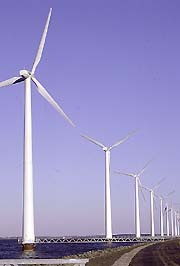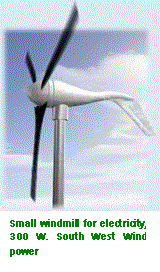| About Us | Contact Us | Contact Database | Support Us |
- MANUAL-
3.2.4
Windmills for Electricity and Pumping
 Windmills that use the wind for electricity generation is the fastest
growing power supply in the world and India is among the world
leaders in the development of large wind turbines for electric
grids. For off-grid installations and pumping a number of smaller
models exist.
Windmills that use the wind for electricity generation is the fastest
growing power supply in the world and India is among the world
leaders in the development of large wind turbines for electric
grids. For off-grid installations and pumping a number of smaller
models exist.
For electricity production the most efficient and popular model
is the one having three blades with horizontal axis. For water
pumping, the multi bladed wind rose is most popular, as its slow
rotation with a piston pump suits to the needs.
Applications:
- Domestic use: to provide power for homes and work in remote areas for lighting, radios, televisions, machines.
- Pumping for drinking water, irrigation and other purposes.
- Large-scale power generation
with connection to the grid.
Advantages:
-
Power generation occurs whenever the wind is blowing, and can operate any time during the day or night.
-
Land around the turbines may still be used for agricultural production.
-
No air/water pollution.
-
All the benefits mentioned in section 3.2.1 under photo-voltaics (PV) are applicable to wind energy; while mostly wind power is cheaper than power from PV.
Disadvantages/problems:
- Substantial initial costs.
- Success depends on a good site, in particular for larger turbines.
- Generation may be intermittent and is best suited to sites with regular and reliable wind patterns, or in combination with other sources (see below).
- Complex rotating machinery requires regular servicing from trained personnel.
- Care must be taken to avoid noise from the turbines, e.g. by keeping a distance to houses.
- small windmills are not used widely in South Asia and are not always available.

A reliable windmill for
electricity of 300 Watt can be bought for €1,000
(Rs. 50,000). In good wind conditions it can generate electricity of
600 KWh/year, with an average of 1.6 KWh/day. Often the windmill generates
2-3 times more electricity than PV panel, both of the same price.
Hand-rules for smaller wind turbines:
The wind increases with height and as a thumb rule a windmill hub (center
of blades) should be 10 m above any obstacle within 100 m. Small windmills
can be combined with a charge controller and batteries connected with
PV system. Because of variations in wind a large battery bank is recommended,
up to 7 days of consumption. Windmills can also be combined with PV or
hydro. PV and hydro give more stable and daily supply, but PV have limitations
because of higher costs and hydro with irregularity in water streams.


